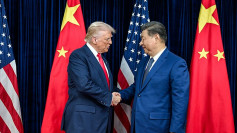China is facing renewed pressure after US president Donald Trump issued fresh threats to raise up trade tariffs. Already at 10 percent, Trump presented a new plan-from that amount, the tariffs will be raised by 25 percent on about $200 billion worth of Chinese imports awaiting entry in the US.
Trump issued this new threat following speculation that China is exploiting US concessions, particularly in the global trade scene. The president issued the threat with a condition-that Beijing agrees to a set of concessions, Reuters reports. Only then will the US back away from the table without imposing the new tariffs. The deadline for China's answer has been set for September 5.
Ever defiant, China appears not to be threatened by the new threat, despite situations facing them at home. Wang Yi, China's top diplomat as well as a State Council member, said that he hoped that others spoke to by Trump "listen carefully." He said that the voice of the US public, as well as members of the international community, are saying something different from the US government in terms of trade.
A trade representative of the US, Robert Lighthizer, said that Trump was forced to issue the threats because of Chinese behavior. He said China, instead of giving in to requests from Trump in exchange of lowering the earlier imposed 10 percent duty tax, retaliated in kind with tariffs on US goods. This affected Trump's decision to issue a potentially new tariff.
Beijing and Washington had been silent the past week. No formal talks were initiated between the country's officials, following Trump's demands regarding intellectual property protection, high technology subsidies, and peer-to-peer technology transfers. China appears not to agree with these terms.
While the US accuses China of corporate espionage and unfair competition through one-sided subsidy, China accuses the US of trying to tilt the balance of economic competition in their favor. So far, this hasn't benefited either country; on China's side, the yuan fell against the dollar, weighed down by certain factors including the high duty taxes. The US, on the other hand, has been working a dole out for sectors heavily affected by the trade dispute.
In what has been hugely unsuccessful talks to end the dispute, the Trump administration tried to broker a deal involving additional US exports to China. China disagreed, and so far, no other negotiations have occurred. However, according to unofficial reports, the two countries remain open to talks where both parties would benefit.





